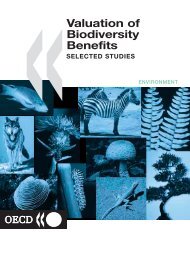You also want an ePaper? Increase the reach of your titles
YUMPU automatically turns print PDFs into web optimized ePapers that Google loves.
Article 56<br />
Drosophila G9a is implicated in germ cell<br />
development<br />
Article 57<br />
Active loss of DNA methylation in two-cell stage<br />
goat embryos<br />
Insect Mol Biol. 2010 Feb; 19(1):131-9.<br />
Int J Dev Biol. 2010; 54(8-9):1323-8.<br />
Lee KS, Yoon J, Park JS, Kang YK *<br />
Park JS, Lee D, Cho S, Shin ST, Kang YK *<br />
* Correspondence: ykkang@kribb.re.kr<br />
Development and Differentiation Research Center<br />
* Correspondence: ykkang@kribb.re.kr<br />
Development and Differentiation Research Center<br />
In Drosophila ovaries, germline stem cells (GSCs) divide<br />
asymmetrically in the germaria to produce daughter GSCs<br />
and cystoblasts. Single cystoblasts differentiate to form germline<br />
cysts with 16 germline cells, all of which are connected<br />
by the fusome, a vesiculated structure critical for oocyte<br />
specification. We here show that histone H3K9 methyltransferase<br />
dg9a is associated with spectrosome/fusome formation<br />
in the germarium; dG9a(13414) mutant ovaries have<br />
disorganized spectrosome/fusome in about half the germaria,<br />
with reduced levels of hu-li tai shao and alpha-SPECTRIN<br />
proteins. We found that the amount of germline cells within<br />
cysts was reduced and that oocyte determination often failed<br />
in egg chambers of the dG9a(13414) mutant ovaries. These<br />
results suggest that a mutation in dG9a gene gives rise to<br />
anomalous spectrosome/fusome structures, which in turn lead<br />
to faulty germ-cell development in Drosophila ovaries.<br />
PMID:20002223<br />
Keywords: dG9a; Drosophila; Fusome; Germline cell;<br />
Histone methylation; Mutation; Oocytes; Oogenesis;<br />
Ovary; Spectrosome<br />
Early mammalian embryos are thought to gain nuclear totipotency<br />
through DNA methylation reprogramming (DMR). By<br />
this process, DNA methylation patterns acquired during gametogenesis<br />
that are unnecessary for zygotic development<br />
are erased. The DMR patterns of various mammalian species<br />
have been studied; however, they do not seem to have a<br />
conserved pattern. We examined early goat embryos to find<br />
conforming rules underlying mammalian DMR patterns.<br />
Immunocytochemical results showed that the overall level<br />
of DNA methylation was not greatly changed during the<br />
pronucleus stage. At the two-cell stage, active demethylation<br />
occurred and simultaneously affected both parental DNAs,<br />
resulting in a global loss of 5-methylcytosine. The level<br />
of DNA methylation was lowest in the four-cell stage, with<br />
increased de novo methylation during the eight-cell stage.<br />
Histone H3-lysine 9 was gradually trimethylated in the<br />
sperm-derived chromatin, continuing from the pronucleus<br />
stage through the two-cell stage. This goat DMR pattern<br />
is novel and distinct from the DMRs of other mammalian<br />
species. The more mammalian species we included for DMR<br />
analysis, the more multifarious patterns we obtained, adding<br />
an extra diversity each time to the known mammalian DMR<br />
patterns. Nevertheless, the evolutionary significance and developmental<br />
consequence of such diverse DMR patterns are<br />
currently unknown.<br />
PMID:20563995<br />
Keywords: Azacitidine; DMR; Embryo, Mammalian;<br />
Enzyme Inhibitors; Epigenetics; Goats; Histone<br />
methylation; Immunohistochemistry; Lysine;<br />
Preimplantation development; Reprogramming;<br />
Zygote<br />
2010 KRIBB Article Abstracts | 33 |












